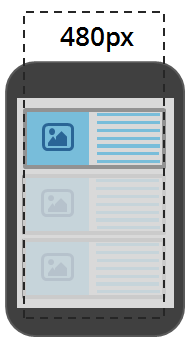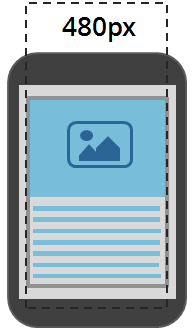Desktop display
Transactional emails sent with Inxmail Commerce are mobile optimised. The display of mobile optimised emails adapts to the device on which the emails are shown. The default setting for emails is a width of 600 px. Devices with a suitably large screen width or screen resolution display emails in the full width of 600 pixels.
There are two different types of mobile optimisation for devices that have a smaller screen size or screen resolution.
Scaling display
In scaling display, the size of an email is reduced proportionally.
Wrapping display
In wrapping display, elements of the email are separated and displayed one below the other (stacked).
Scaling and wrapping modules in Inxmail Commerce
Some modules are only available in a scaling version. This includes, for example, the One-column image module: This type of image extends across the entire width of the email. Only scaling makes sense here.
Modules that consist of two or more elements and that can be wrapped in a way that makes sense are available both in a scaling and a wrapping version. This is the case for the Image/Text module, for example. After being inserted in the mailing, these types of modules allow you to specify whether the mailing should be displayed with scaling or wrapping in mobile view.
In wrapping display, you can specify whether the elements should cover the entire width of the display (option 1) or whether they should keep the size from the desktop display (option 2).
|
|
Option 1 |
|
Option 2 |
If you are considering option 1, you need to bear in mind that the elements will be displayed larger than in the scaling display and possibly also larger than in the desktop display.
Option 2 allows you to define how the modules are aligned (left, centre, right).
Different factors can influence whether you choose to use a scaling or wrapping display for the mobile view. For example, the image quality that you can provide can play a role. Wrapping display requires a high picture quality due to the size of the images. Another aspect could concern what the article is communicating. If it is important for this that the article should be seen as belonging together, it may be better to use a scaling display.







